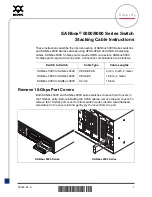
4 Configuration
D-Link Web Smart Switch User Manual
40
By default, IGMP is disabled. If enabled, the IGMP Global Settings will need to be entered:
It is recommended to keep Report to all ports enable to ensure the functionality of SmartConsole Utility.
Host Timeout (130-153025 sec):
This is the interval after which a learned host port entry will be purged. For
each host port learned, a 'Port Purge Timer' runs for 'Host Port Purge Interval'. This timer will be restarted
whenever a report message from host is received over that port. If no report messages are received for 'Host
Port Purge Interval' time, the learned host entry will be purged from the multicast group. The default value is
260 seconds.
Robustness Variable (2-255 sec):
The Robustness Variable allows adjustment for the expected packet loss
on a subnet. If a subnet is expected to be lossy, the Robustness Variable may need to be increased. The
Robustness Variable cannot be set to zero, and it SHOULD NOT be. Default is 2 seconds.
Query Interval (60-600 sec):
The Query Interval is the interval between General Queries sent. By adjusting
the Query Interval, the number of IGMP messages can be increased or decreased; larger values will cause
IGMP Queries to be sent less often. Default value is 125 seconds.
Router Timeout (60-600 sec):
This is the interval after which a learned router port entry will be purged. For
each router port learned, a 'Router Port Purge Timer' runs for 'Router Port Purge Interval'. This timer will be
restarted whenever a Query control message is received over that port. If there are no Query control
messages received for 'Router Port Purge Interval' time, the learned router port entry will be purged. Default
is 260 seconds.
Last Member Query Interval (1-25 sec):
The Last Member Query Interval is the Max Response Time
inserted into Group-Specific Queries sent in response to Leave Group messages, and is also the amount of
time between Group-Specific Query messages. This value may be adjusted to modify the "leave latency" of
the network. A reduced value results in reduced time to detect the loss of the last member of a group. Default
is 1 second.
Max Response Time (10-25 sec):
The Max Response Time specifies the maximum allowed time before
sending a responding report message. Adjusting this setting effects the "leave latency", or the time between
the moment the last host leaves a group and when the multicast server is notified that there are no more
members. It also allows adjustments for controlling the frequency of IGMP traffic on a subnet. Default is 10
seconds.
To enable IGMP snooping for a given VLAN, select enable and click on the
Apply
button. Then press the
Edit
button under
Router Port Setting
, and select the ports to be assigned as router ports for IGMP
snooping for the VLAN, and press
Apply
for changes to take effect. A router port configured manually is a
Static Router Port
, and a
Dynamic Router Port
is dynamically configured by the Switch when query control
message is received.
Figure 4.53 – L2 Functions > Multicast > IGMP Snooping VLAN Settings
State :
Specify the State to be enabled or disabled.
Querier State:
D-Link Smart Switch is able to send out the IGMP Queries to check the status of multicast
clients. Default is disabled.
















































